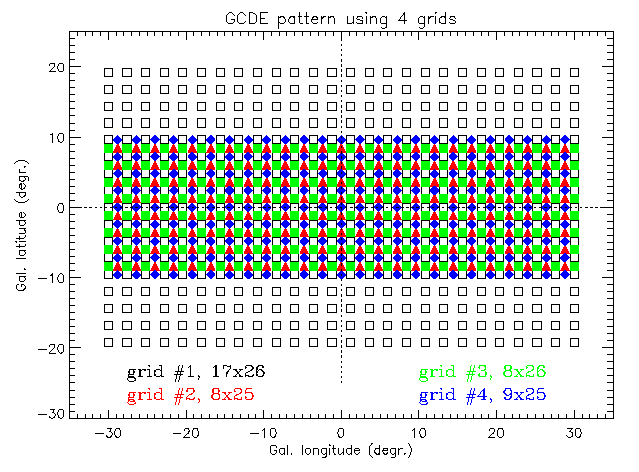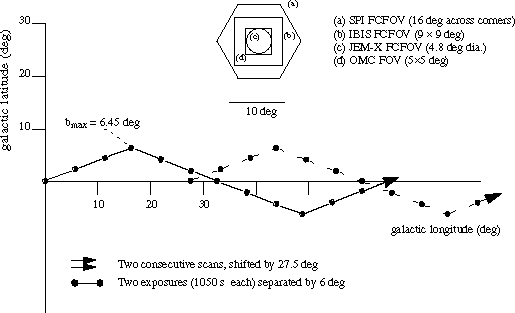INTEGRAL AO-1 Core Programme
(Guaranteed Time)
The Core Programme consists of three elements,
which are in priority
(1) A Deep exposure of the Galactic
Central Radian (GCDE): 4.30 x 106 sec
(2) Regular scans of the Galactic Plane (GPS):
2.30 x 106 sec
(3) Pointed observations of selected sources:
2.72 x 106 sec
Full details on the core programme can be found
here.
A summary is given below.
(1) Deep exposure of the Galactic Central Radian
(GCDE):
The central radian of the Galaxy will be observed using a pattern of
4 rectangular pointing grids symmetric around the Galactic Centre with
a pitch of 2.4 deg.
Grid 1: 17 x 26 points (442 points), l = +/- 30 deg, b = +/- 19.2 deg,
Grid 2: 8 x 25 points (200 points), l = +/- 29.8 deg, b = +/- 8.4 deg
Grid 3: 8 x 26 points (208 points), l = +/- 30.0 deg, b = +/- 8.4 deg,
Grid 4: 9 x 25 points (225 points), l = +/- 28.8 deg, b = +/- 9.6 deg

This pattern is chosen to minimise SPI imaging artefacts and to optimize
the IBIS sensitivity towards the Galactic plane. Within |b| < 10 deg
the grids are shifted relative to each other by 1.2 deg (1/2 pitch). By
using 4 grids the exposure ratio of the areas within |b| < 10 deg and
|b| > 10 deg becomes 4:1. Slew time between points is conservatively assumed
to be ~ 200 s using the specification value for a 6 deg open loop slew
(300 s). The nominal exposure per point is 30 minutes.
The total duration of one cycle (one pattern of 4 grids including slews)
is estimated at 2.15 x10^6 s. Within the total time allocation for the
GCDE one cycle will be performed twice per year. Due to visibility constraints,
the entire pattern never can be scanned at once, but ISOC will schedule
a series of subscans (rasters). |
(2) Regular scans of
the Galactic Plane (GPS):
The baseline set of parameters describing the
GPS scans are the result of an optimization process taking spacecraft and
ground segment elements, instrument characteristics and scientific objectives
into account. Basically the scans will be performed once a week by executing
a "slew and stare" manoeuvre of the spacecraft across the visible (accessible)
part of the Galactic plane with an extent in latitude up to +/-10 deg.
The angular distance between two "staring points" along the scan path is
6 deg, the extremes in latitude of the pointings are at b = +/- 6.45 deg.
The scans will be performed in a sawtooth pattern with an inclination of
21 deg with respect to the Galactic plane, each subsequent scan being shifted
by 27.5 deg in galactic longitude. A schematic view of two consecutive
scans is shown in the Figure below. The sum of all GPS scans during a year
provides a set of grid points ("dither pattern") which facilitates the
imaging with SPI. The accessible part of the Galactic plane depends on
viewing constraints, including the solar aspect angle, and on the season
of the year.
 |
(3) Core Programme Pointed Observations (sorted
with target RA in ascending order):
For year 1 (AO-1) the CP guaranteed time for pointed observations (total
for year 1 = 2.72 x10^6 s, see above) is split up as follows:
-
1.7 x 10^6 s (max) for unknown and known transient sources,
-
1.0 x 10^6 s (max) for the persistent Vela observation, (see below
for details).
Proposal ID
click on ID for abstract
|
Title
|
PI
|
Target
|
RA (J2000) [deg]
|
Decl (J2000) [deg]
|
Time [ksec]
|
| 0110009 |
INTEGRAL CP Observations of the Vel region |
ISWT |
Vela region |
133.189859
|
-44.585333
|
1000
|
| 0110011 |
INTEGRAL CP TOO Observations: Mrk 501 |
ISWT |
Mrk 501 |
253.467917
|
39.760194
|
300
|
| 0110006 |
INTEGRAL CP Observations of TOOS: Galactic transient events |
ISWT |
GX 339-4 |
255.706250
|
-48.789722
|
300
|
| 0110006 |
INTEGRAL CP Observations of TOOS: Galactic transient events |
ISWT |
1E 1740-2942 |
266.011250
|
-29.723611
|
300
|
| 0110010 |
INTEGRAL CP Observations of TOOs: Superluminal sources |
ISWT |
GRS 1915+105 |
288.797917
|
10.945556
|
200
|
| 0110010 |
INTEGRAL CP Observations of TOOs: Superluminal sources |
ISWT |
GRO J1655-40 |
298.501042
|
-39.845833
|
200
|
| 0110006 |
INTEGRAL CP Observations of TOOS: Galactic transient events |
ISWT |
Cyg X-1 |
299.590333
|
35.201611
|
300
|
| 0110006 |
INTEGRAL CP Observations of TOOS: Galactic transient events |
ISWT |
Cyg X-3 |
308.110833
|
40.952500
|
300
|
| 0110001 |
INTEGRAL CP observations of TOOs: SNe (Ia and local type II) |
Integral Science Working Team (ISWT) |
SN Ia |
any
|
any
|
2000
|
| 0110001 |
INTEGRAL CP observations of TOOs: SNe (Ia and local type II) |
ISWT |
SN II |
any
|
any
|
3000
|
| 0110005 |
INTEGRAL CP observations of TOOs: Classical Novae |
ISWT |
Classical novae |
any
|
any
|
1200
|
| 0110002 |
INTEGRAL CP TOO observations: Previously unknown X/-gamma-ray transients |
ISWT |
New X-/gamma-ray transient |
any
|
any
|
1600
|
Strategy for the selection of unknown and known transient sources:
These events can be triggered from INTEGRAL detections of a "high
state" during the GPS and/or GCDE observations or from observations external
to INTEGRAL (e.g. ground-based optical telescopes) and are considered as
TOO follow-up observations.
The following strategy will be applied: the allocation of 1.7 x 10^6
s for year one shall be used for either the following unknown
transient sources of the following type:
-
local group SN II, SN Ia, classical novae, previously unknown X-/gamma-transients
-
and/or the known transient sources (GRS 1915+105, GROJ1655-40,1E740.7-2942,Cyg
X-1, Cyg X-3, GX 339-4, Mrk 501)
whatever TOO event comes first. The trigger criteria (see
AO1 documentation) have been defined so that the events listed above become
scientifically an exceptionally unique - and for INTEGRAL important - target.
Note on TOO follow-up observations:
It is expected that most TOO events will be detected during the Core
Programme elements GPS and GCDE: this is one of the main reasons to perform
the GPS and GCDE during the entire mission. TOO follow-up observations
are scientifically important for INTEGRAL and a situation should be avoided
where they cannot be scheduled because a specific time allocation (e.g.
CP pointed observations for TOO follow-up observations) has been formally
exhausted. Therefore, if at any time during an observation period of one
year -- corresponding to one INTEGRAL AO cycle -- a TOO follow-up observation
triggered by a detection in GPS and/or GCDE data is scheduled and executed
and if the CP allocated time for TOO follow-up observations is already
exhausted, then the data of the entire field-of-view of that follow-up
observation will be made publicly available immediately, unless a AO-1
accepted proposal exists (see "General Programme", above). See also AO-1
documentation on "Science
Data Rights" for full details.
It is understood that some flexibility should be kept by the ISWT in
case a major ("once in a lifetime") TOO event (e.g. close-by SN) occurs
and no or insufficient CP time for follow up observations is available
anymore because the ceiling has been already reached. In this case the
ISWT could review the priority assigned for the GCDE and GPS and, if available,
probably re-assign remaining time from these CP elements. This would be
an exception to the routine case where the execution of TOO follow-up observations
will be decided by the Project Scientist. See also AO-1 documentation on
"Guaranteed Time"
for full details.
The General Programme (open time) observations, which complete the
INTEGRAL observing programme, can be found here.
Last Updated on 17.08.2001
ESA/ISOC

